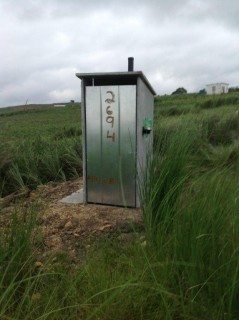Glassfibre Reinforced Convenience
Instead of clinging on to the convoluted brick and mortar construction methods, Southern Africa has started to use Glass Reinforced Concrete sandwich wall panels to address its mounting basic services infrastructure backlog, writes PETER RADEMAN, Director of GRC Marketing.
So you think the concept of reinforcing concrete with glassfibre is something new? Haven’t you heard that ancient Egyptians devised something on its lines?
The ancient Egyptians were able to improve the properties of ordinary clay by adding straw and so converted it into a material which could be used for construction. Some examples of this exist to this day. For centuries, it was a dream to be able to do the same for Portland cement bound composites in areas where there was no clay. Amongst the possible fibres which could be used for this was fiberised glass but the problem was that the alkali environment of hydrating cement attacks the glass fibres and the composite looses some of its properties.

Breakthrough
The breakthrough came in the 1960’s when the British Building Research Institute discovered that alkali resisting properties were achieved by adding zircon oxide to the raw material constituents of the fibreglass. This discovery was taken over and initially developed by Pilkingtons of England then later commercialised by Owens Corning in the USA. Today, Glassfibre Reinforced Concrete is one of the most versatile building materials available to architects and engineers and alkali resistant glassfibres are produced in various factories around the world to supply the fast growing demand.
High performance composites
GRC is not a single material but rather a family of high performance cement bound composites reinforced with variable percentages of special alkali resistant glassfibres to provide designed strength. The high tensile strength and the fact that the glassfibre reinforcement does not rust or suffer from any degradation due to the environment means that no cover is needed to protect it. This enables the material to be used for products which require a thin skin with high strength. Products with skin thicknesses down to 10mm are possible. In general, Glassfibre Reinforced Concrete presents architects and engineers with a material from which the most ambitious designs can be created in highly moulded futuristic or traditional profile.
Typical applications
Some typical applications for Glassfibre Reinforced Concrete are: Water and drainage products, permanent formwork in Bridge decks and tunnels, Modular building, Roofing, Cladding, Features and Mouldings, Landscaping, and Architectural Panels and Features.
Significance in Southern Africa
There is high demand for basic structures like houses, classrooms and clinics, mostly in remote and inaccessible locations in Africa. Hence to meet this, the local range of products is specially designed fabricated with a simpler pattern than in other parts of the world.
GRC is mostly made into sandwich panels for walling. It encapsulates a core material to provide a robust well insulated walling unit which can be tailored to suit a range of environments.
For South Africa, in particular, Glassfibre Reinforced Concrete sandwich wall panels are even handier, bearing in mind that the flood of immigrants into RSA from neighbouring countries has overstressed the supply of structures for basic services like toilet ablution blocks, houses and clinics.
GRC Marketing are the accredited suppliers to such esteemed manufacturers as Wilson Stone for architectural panels and products as well as IzwelethuCemforce’s Agreement certified toilets which are used through out RSA and comprising of Glass Reinforced Concrete (GRC) sandwich wall and roof panels.

